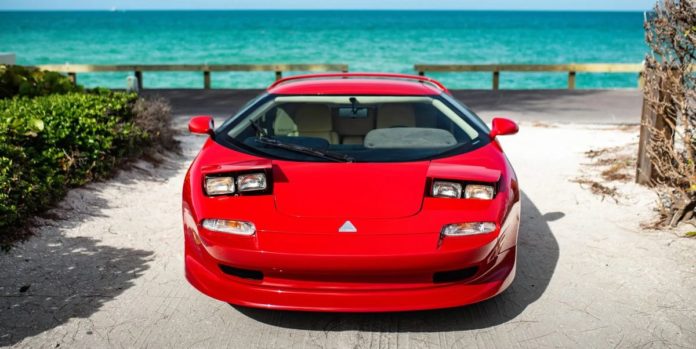- With the V-12 heart of a Diablo and wild styling, the Vector M12 is the 1990s supercar you never knew existed, and it’s up for auction on Bring a Trailer until April 22.
- It was born from the ashes of the wild Vector W8; of 14 production M12s built, perhaps only a dozen remain.
- This example was reviewed when new by Top Gear. And yes, those signal lights are borrowed off an original Mazda Miata.
What’s powered by a 60-degree V-12 but is more than 100 times rarer than a Lamborghini Countach, has the same designer as the McLaren F1, and was built in (checks notes) Florida? It’s the Vector M12, the followup mid-engine supercar to Jerry Wiegert’s ill-fated, F117-inspired W8. With fewer than 14 production versions made, and two of those now reportedly destroyed in crashes, it’s one of the rarest exotics of them all. Now here’s your chance at showing up the Lamborghini Diablos at your next ’90s-themed car show.
Pick of the day at auction site Bring a Trailer (which, like Car and Driver, is part of Hearst Autos) is Vector M12 production chassis number four, presented with just 4400 miles on its odometer. It just so happens to be the example featured on the old version of BBC’s Top Gear, and if you’d like to see a young and poodle-haired Jeremy Clarkson review this very car, you should check it out. Suffice to say Clarkson has both good and bad things to say about this low-slung American-Italian supercar.
The M12 was born from the ashes of the fall of Vector, one of those what-might-have-been tales of American supercar ambition not unlike that of the Cizeta-Moroder V16T. The late Jerry Wiegert dreamed big, working for years to bring his vision for an aerospace-inspired performance machine to production. The closest he got was the wedge-like Vector W8, its exterior and interior design intended to evoke the F117 Nighthawk stealth plane. It entered production in 1989 with bodywork incorporating carbon fiber and Kevlar, and a twin-turbocharged 6.0-liter V-8.
Unfortunately, like Icarus, Vector flew too close to the sun and fell to earth. The story is complex, but a combination of some well-publicized teething issues and a hostile takeover attempt by a primary shareholder called Megatech resulted in Wiegert losing control of his company. He later sued to get his designs and copyrights back.
In the meantime, Megatech hired U.K. designer Peter Stevens to rework the W8’s styling and went looking for a production-ready powertrain. The company didn’t have far to look, as at the time it had recently purchased Lamborghini. Instead of the W8’s transversely mounted, twin-turbocharged V-8 with a three-speed automatic transmission (yes, really), the M12 was fitted with a longitudinally mounted 5.7-liter V-12 and a five-speed manual transmission sourced from the Diablo. Just a few years later, Megatech sold the prancing bull of Sant’Agata to Audi, and the rest is history.
But in that brief window, the M12 shone as a moment of pure mid-1990s excess. Modern supercars can be swift and eye-catching, and they can howl like banshees. For the most part though, they offer a carefully curated experience, and driving them is about as dangerous as putting on a hat. As Clarkson pointed out his in-period review, the M12 is work.
It’s as fast as you could want, knocking on 500 horsepower from that screaming V-12. Everything else about it is love it or hate it, from the over-the-top looks to the occasionally suspect build quality. Three-spoke wheels are just icing on the cake.
This example has had some recent work, with replacement of the power steering pump and rack, and servicing and rebuilding the front brakes. It has been driven sparingly, with just 500 miles added over the past half-decade. Still, well done to the previous owner for getting out and actually driving it.
Here’s hoping the winning buyer does too. The Vector M12 may have existed only for a brief moment in time, but there’s almost nothing else like it out there. The world deserves to see it hit the road.
The auction ends April 22.

Brendan McAleer is a freelance writer and photographer based in North Vancouver, B.C., Canada. He grew up splitting his knuckles on British automobiles, came of age in the golden era of Japanese sport-compact performance, and began writing about cars and people in 2008. His particular interest is the intersection between humanity and machinery, whether it is the racing career of Walter Cronkite or Japanese animator Hayao Miyazaki’s half-century obsession with the Citroën 2CV. He has taught both of his young daughters how to shift a manual transmission and is grateful for the excuse they provide to be perpetually buying Hot Wheels.




